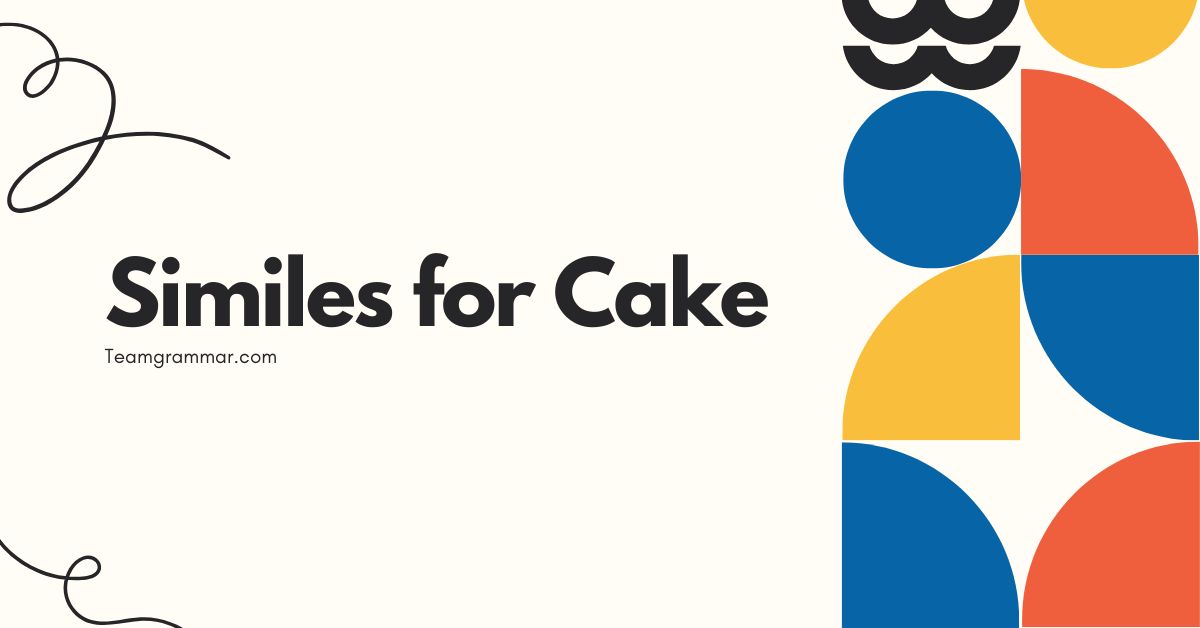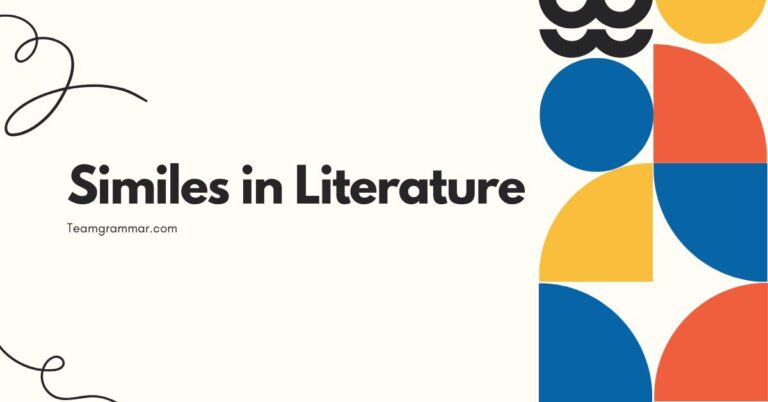31 Similes for Cake: A Delicious Dive into Figurative Language
Understanding similes is crucial for enhancing both your writing and comprehension skills. Similes, a type of figurative language, allow us to draw comparisons between two unlike things using “like” or “as,” adding depth and vividness to our descriptions.
This article focuses specifically on similes related to “cake,” providing numerous examples and explanations to help you master this concept. Whether you’re a student, writer, or simply an English enthusiast, this guide will offer valuable insights and practical exercises to improve your understanding and usage of similes.
Table of Contents
- Introduction
- Definition of Simile
- Structural Breakdown of a Simile
- Types of Similes
- Examples of Similes for Cake
- Usage Rules for Similes
- Common Mistakes with Similes
- Practice Exercises
- Advanced Topics in Similes
- Frequently Asked Questions
- Conclusion
Definition of Simile
Asimileis a figure of speech that directly compares two different things using the words “like” or “as.” The purpose of a simile is to create a more vivid and descriptive image in the reader’s mind. It helps to explain something unfamiliar by relating it to something familiar.
Similes are widely used in literature, poetry, and everyday language to enhance communication and add artistic flair.
Similes belong to the broader category offigurative language, which also includes metaphors, personification, and hyperbole. Unlike a metaphor, which states that one thing *is* another, a simile only suggests a resemblance.
The function of a simile is to draw attention to a specific quality or characteristic shared by the two things being compared. This comparison helps the reader or listener understand the subject in a new or more insightful way.
The context in which a simile is used can greatly affect its meaning and impact, making it a versatile tool for writers and speakers.
Structural Breakdown of a Simile
The basic structure of a simile involves three key components: the subject, the linking word (“like” or “as”), and the object of comparison. Understanding this structure is crucial for creating effective and clear similes.
1. Subject: This is the thing being described or compared. It’s the focus of the simile.
2. Linking Word: This is either “like” or “as,” connecting the subject to the object of comparison. These words signal that a comparison is being made, rather than a direct statement of identity.
3. Object of Comparison: This is the thing to which the subject is being compared. It should share a relevant characteristic with the subject to make the comparison meaningful.
For example, in the simile “The cake was as light as a feather,” “cake” is the subject, “as” is the linking word, and “feather” is the object of comparison. The simile highlights the cake’s lightness by comparing it to a feather.
Types of Similes
Similes can be categorized based on the nature of the comparison they make. Understanding these different types can help you choose the most effective simile for your writing or speaking.
Positive Similes
Positive similes are used to express a favorable or desirable quality of the subject. They highlight something good or positive about the subject by comparing it to something else that is also considered positive.
Negative Similes
Negative similes are used to express an unfavorable or undesirable quality of the subject. They highlight something bad or negative about the subject by comparing it to something else that is also considered negative.
Comparative Similes
Comparative similes are used to compare the degree or extent of a quality between the subject and the object of comparison. These similes often involve adverbs or adjectives that indicate a degree of comparison, such as “more,” “less,” “better,” or “worse.”
Examples of Similes for Cake
Here are several examples of similes related to cake, categorized by the aspect of the cake they describe. These examples will help you understand how similes can be used to create vivid and descriptive language.
Texture Similes
These similes focus on the way the cake feels, whether it’s soft, dense, crumbly, or moist.
The table below provides examples of texture-based similes for cake. These similes use words like “soft,” “crumbly,” and “dense” to create a vivid image of the cake’s texture.
| Simile | Explanation |
|---|---|
| The cake was as soft as a cloud. | Describes a very light and airy texture. |
| The frosting was like velvet on the tongue. | Emphasizes the smooth and luxurious feel of the frosting. |
| The cake was as crumbly as dry sand. | Describes a cake that falls apart easily. |
| It was like biting into a sponge, so light and airy. | Highlights the cake’s airy texture by comparing it to a sponge. |
| The cake was as dense as a brick. | Describes a heavy and compact texture. |
| The layers were as moist as dew-kissed grass. | Emphasizes the cake’s moistness through a natural comparison. |
| The texture was like biting into a sweet dream. | Conveys a pleasant and ethereal texture. |
| Each bite felt as smooth as silk. | Highlights the smooth texture of the cake or frosting. |
| The cake was as fluffy as a kitten’s fur. | Describes a light and airy texture. |
| The crumb of the cake was like velvet. | Emphasizes the fine and smooth texture of the cake’s crumb. |
| It was as chewy as a gummy bear. | Describes a cake with a slightly elastic texture. |
| The cake was as firm as a well-made mattress. | Describes a cake with a solid and supportive texture. |
| The frosting was like a creamy waterfall in my mouth. | Emphasizes the smooth and flowing texture of the frosting. |
| The cake was as gritty as sandpaper. | Describes an unpleasantly rough texture. |
| The texture was like biting into cotton candy. | Conveys a light, airy, and melt-in-your-mouth texture. |
| The cake felt as springy as a trampoline. | Describes a cake with a resilient and bouncy texture. |
| The cake was as hard as a rock. | Describes a very firm and dense cake. |
| It was like eating a cloud, so light and airy. | Highlights the cake’s light and airy texture. |
| The cake’s texture was as delicate as lace. | Describes a fine and fragile texture. |
| The filling was like a burst of liquid silk. | Emphasizes the smooth and flowing texture of the filling. |
| The cake was as airy as whipped cream. | Describes the light and airy texture of the cake. |
| It was like biting into a pillow, so soft and yielding. | Highlights the soft and yielding texture of the cake. |
| The cake was as compact as fudge. | Describes the dense and rich texture of the cake. |
Taste Similes
These similes describe the flavor of the cake, whether it’s sweet, rich, tangy, or subtle.
The table below provides examples of taste-based similes for cake. These similes use words like “sweet,” “rich,” and “tangy” to create a vivid image of the cake’s flavor.
| Simile | Explanation |
|---|---|
| The cake was as sweet as honey. | Describes a very sweet flavor. |
| The chocolate was like a dark, rich symphony in my mouth. | Emphasizes the complex and intense flavor of the chocolate. |
| The lemon cake was as tangy as a fresh lime. | Describes a tart and zesty flavor. |
| The taste was like sunshine on a cloudy day. | Conveys a bright and cheerful flavor. |
| The cake was as bland as cardboard. | Describes a flavorless and unappetizing taste. |
| The aftertaste lingered like a sweet memory. | Emphasizes the pleasant and lasting flavor. |
| The flavor was like a party in my mouth. | Conveys a diverse and exciting taste experience. |
| Each bite tasted as decadent as a sin. | Highlights the rich and indulgent flavor. |
| The cake was as subtle as a whisper. | Describes a delicate and understated flavor. |
| The vanilla was like a warm hug on a cold day. | Emphasizes the comforting and familiar flavor of vanilla. |
| It was as bitter as disappointment. | Describes an unpleasantly sharp and intense flavor. |
| The flavor combination was like a perfectly balanced equation. | Describes a harmonious and well-integrated taste. |
| The sweetness was like a gentle caress on my palate. | Emphasizes the delicate and pleasing sweetness. |
| The cake was as artificial as a plastic flower. | Describes a synthetic and unnatural flavor. |
| The taste was like a burst of summer in my mouth. | Conveys a refreshing and vibrant flavor. |
| Each bite tasted as heavenly as ambrosia. | Highlights the divine and exquisite flavor. |
| The cake was as sour as a lemon gone bad. | Describes a tart and unpleasant flavor. |
| It was like drinking liquid gold, so rich and smooth. | Highlights the rich and smooth flavor of the cake or frosting. |
| The flavor was as complex as a fine wine. | Describes a sophisticated and multi-layered taste. |
| The spices were like a warm embrace on my tongue. | Emphasizes the comforting and aromatic flavor of the spices. |
| The cake was as zesty as a freshly peeled orange. | Describes the cake’s bright and citrusy flavor. |
| It was like tasting sunshine, bright and cheerful. | Highlights the cake’s cheerful and uplifting flavor. |
| The cake was as rich as a king’s ransom. | Describes the decadent and luxurious flavor of the cake. |
Appearance Similes
These similes focus on how the cake looks, including its color, shape, and decorations.
The table below provides examples of appearance-based similes for cake. These similes use visual comparisons to create a vivid image of the cake’s aesthetic qualities.
| Simile | Explanation |
|---|---|
| The cake was as golden as the setting sun. | Describes a warm, radiant color. |
| The frosting was like a swirling galaxy of colors. | Emphasizes the intricate and mesmerizing pattern of the frosting. |
| The cake looked as perfect as a picture. | Describes a flawless and aesthetically pleasing appearance. |
| It was like a work of art, so beautifully decorated. | Highlights the artistic and decorative elements of the cake. |
| The cake was as plain as a white wall. | Describes a simple and unadorned appearance. |
| The layers were stacked as neatly as books on a shelf. | Emphasizes the precise and orderly arrangement of the layers. |
| The cake looked like a fairytale castle. | Conveys a whimsical and enchanting appearance. |
| Each detail was as delicate as spun sugar. | Highlights the fine and intricate details of the cake’s decoration. |
| The cake was as bright as a rainbow. | Describes a vibrant and colorful appearance. |
| The chocolate ganache was like a glossy mirror. | Emphasizes the smooth and reflective surface of the ganache. |
| It was as lopsided as a leaning tower. | Describes an uneven and unbalanced appearance. |
| The decorations were as elaborate as a royal crest. | Emphasizes the ornate and detailed nature of the decorations. |
| The cake looked like a fluffy white cloud. | Conveys a light and airy appearance. |
| The cake was as dark as midnight. | Describes a deep and intense color. |
| It was like a garden in bloom, so many flowers. | Highlights the floral decorations of the cake. |
| Each layer was as even as a ruler’s line. | Emphasizes the uniform and precise construction of the cake. |
| The cake was as messy as a child’s painting. | Describes a chaotic and disorganized appearance. |
| The decorations were like tiny jewels. | Emphasizes the precious and sparkling elements of the cake. |
| The cake was as pale as moonlight. | Describes a soft and subtle color. |
| The frosting was like a blanket of snow. | Emphasizes the smooth and even covering of the frosting. |
| The cake was as vibrant as a tropical sunset. | Describes the cake’s bright and vivid colors. |
| It was like a miniature landscape, with hills and valleys of frosting. | Highlights the textured and dimensional appearance of the cake. |
| The cake was as extravagant as a wedding gown. | Describes the elaborate and luxurious appearance of the cake. |
Feeling/Emotion Similes
These similes describe the feelings or emotions evoked by the cake, such as happiness, comfort, or nostalgia.
The table below provides examples of feeling/emotion-based similes for cake. These similes use emotional comparisons to convey the feelings associated with enjoying the cake.
| Simile | Explanation |
|---|---|
| The cake tasted like happiness in every bite. | Conveys a feeling of joy and delight. |
| Eating the cake was like a warm hug on a cold day. | Emphasizes the comforting and reassuring feeling. |
| The cake brought back memories like an old photograph. | Describes a feeling of nostalgia and reminiscence. |
| It felt like a celebration in my mouth. | Highlights the festive and celebratory feeling. |
| The cake left me feeling as empty as a hollow shell. | Describes a feeling of disappointment and dissatisfaction. |
| The anticipation was like a child waiting for Christmas morning. | Emphasizes the excitement and eagerness. |
| The cake tasted like home. | Conveys a feeling of warmth, comfort, and familiarity. |
| Each bite felt as satisfying as a completed goal. | Highlights the sense of accomplishment and fulfillment. |
| The cake was as comforting as a mother’s embrace. | Describes a feeling of security and warmth. |
| The sweetness was like a gentle reminder of simpler times. | Emphasizes a feeling of nostalgia and innocence. |
| It was as disappointing as a cancelled vacation. | Describes a feeling of frustration and letdown. |
| The cake made me feel like a kid again. | Conveys a feeling of youthful joy and carefree spirit. |
| The flavor was like a sweet escape from reality. | Emphasizes a feeling of relaxation and indulgence. |
Overall Quality Similes
These similes provide an overall assessment of the cake’s quality, often combining elements of taste, texture, and appearance.
The table below provides examples of similes that describe the overall quality of the cake, combining elements of taste, texture, and appearance to provide an overall assessment of the cake’s excellence.
| Simile | Explanation |
|---|---|
| The cake was as perfect as a dream. | Describes an ideal and flawless quality. |
| The cake was as good as it gets. | Conveys a sense of ultimate satisfaction. |
| The cake was like a masterpiece. | Highlights the exceptional skill and artistry. |
| It was like heaven on a plate. | Emphasizes the divine and blissful quality. |
| The cake was as bad as it could possibly be. | Describes an extremely poor and unpleasant quality. |
| The cake was a disaster, like a failed experiment. | Conveys a sense of complete failure and disappointment. |
| The cake was like a symphony of flavors and textures. | Highlights the harmonious blend of different elements. |
| Each bite was as delightful as a perfect day. | Emphasizes the joy and pleasure derived from the cake. |
| The cake was as memorable as a first love. | Describes a lasting and unforgettable quality. |
| The overall experience was like a sweet escape. | Emphasizes the enjoyable and relaxing nature of the cake. |
| It was as disappointing as an unfulfilled promise. | Describes a feeling of letdown and dissatisfaction. |
| The cake was a triumph, like a well-deserved victory. | Conveys a sense of accomplishment and success. |
| The cake was like a warm blanket on a cold night. | Emphasizes the comforting and soothing quality. |
Usage Rules for Similes
Using similes effectively involves following certain rules to ensure clarity and impact. Here are some key usage rules to keep in mind:
1. Clarity: The comparison should be clear and easy to understand. The object of comparison should be something familiar to the audience.
2. Relevance: The shared characteristic between the subject and the object of comparison should be relevant and meaningful.
3. Originality: While common similes can be effective, strive for originality to make your writing more engaging and memorable.
4. Context: The simile should fit the context of the writing or speaking. Consider the tone, audience, and purpose of the communication.
5. Avoid Clichés: Avoid overused similes (clichés) such as “as busy as a bee” or “as strong as an ox”. These can make your writing seem unoriginal and uninspired.
6. Consistency: Ensure the comparison is consistent with the overall description. Don’t use a simile that contradicts other details or descriptions.
Common Mistakes with Similes
Several common mistakes can weaken the effectiveness of similes. Being aware of these mistakes can help you avoid them and create stronger, more impactful comparisons.
1. Using Metaphors Instead of Similes: Confusing similes with metaphors is a common error. Remember that similes use “like” or “as” to make a comparison, while metaphors directly equate two things.
- Incorrect (Metaphor): The cake was a cloud.
- Correct (Simile): The cake was *like* a cloud.
2. Using Unclear Comparisons: The object of comparison should be something familiar and easily understood. Avoid using obscure or abstract comparisons that may confuse the reader.
- Incorrect: The cake was as sweet as ambrosia to a god. (Not everyone knows what ambrosia is)
- Correct: The cake was as sweet as honey.
3. Using Clichés: Overused similes can make your writing seem unoriginal and uninspired. Try to come up with fresh and creative comparisons.
- Cliché: The cake was as light as a feather.
- Better: The cake was as light as a dandelion seed floating in the breeze.
4. Using Illogical Comparisons: The shared characteristic between the subject and the object of comparison should be logical and relevant. Avoid making comparisons that don’t make sense.
- Incorrect: The cake was as loud as a trumpet. (Cakes don’t make sounds)
- Correct: The cake was as vibrant as a trumpet fanfare. (Referring to its presentation)
5. Overusing Similes: While similes can enhance your writing, using too many in a short space can make it seem forced and unnatural. Use similes sparingly and strategically.
Practice Exercises
Test your understanding of similes with these practice exercises. Identify the subject, linking word, and object of comparison in each simile.
Then, create your own similes for cake based on the given prompts.
Exercise 1: Identify the parts of the simile.
In the table below, identify the subject, linking word, and object of comparison in each simile.
| Simile | Subject | Linking Word | Object of Comparison |
|---|---|---|---|
| The cake was as rich as chocolate fudge. | Cake | as | chocolate fudge |
| The frosting was like a sweet dream. | Frosting | like | a sweet dream |
| The cake was as fluffy as a cloud. | Cake | as | a cloud |
| The taste was like sunshine. | Taste | like | sunshine |
| The cake was as dense as a brick. | Cake | as | a brick |
| The cake was as golden as the sun. | Cake | as | the sun |
| The filling was like liquid silk. | Filling | like | liquid silk |
| The cake was as bland as cardboard. | Cake | as | cardboard |
| The cake was as comforting as a hug. | Cake | as | a hug |
| The decorations were like jewels. | Decorations | like | jewels |
Exercise 2: Create your own similes for cake based on the following prompts.
In the table below, create your own similes for cake based on the prompts provided.
| Prompt | Your Simile |
|---|---|
| Describe the sweetness of the cake. | The cake was as sweet as maple syrup. |
| Describe the texture of the cake. | The cake was like biting into a soft pillow. |
| Describe the appearance of the cake. | The cake was as colorful as a rainbow. |
| Describe the feeling of eating the cake. | Eating the cake was like a comforting hug. |
| Describe the overall quality of the cake. | The cake was as perfect as a dream come true. |
| Describe the moistness of the cake. | The cake was as moist as a rainforest floor. |
| Describe the richness of the cake. | The cake was as rich as a king’s treasure. |
| Describe the aroma of the cake. | The aroma of the cake was like a warm embrace. |
| Describe the frosting of the cake. | The frosting was like a creamy waterfall. |
| Describe the decoration of the cake. | The decorations were like tiny, edible jewels. |
Exercise 3: Rewrite the sentences below using similes.
Rewrite the sentences below using similes to add more descriptive language.
| Original Sentence | Rewritten Sentence with Simile |
|---|---|
| The cake was very sweet. | The cake was as sweet as a jar of honey. |
| The cake was soft. | The cake was like a cloud in my mouth. |
| The cake looked beautiful. | The cake looked as beautiful as a wedding bouquet. |
| The cake was comforting. | The cake was as comforting as a warm fire on a cold night. |
| The cake tasted delicious. | The cake tasted like a slice of heaven. |
| The cake was moist. | The cake was as moist as morning dew on grass. |
| The cake was rich. | The cake was as rich as a decadent chocolate truffle. |
| The aroma of the cake was strong. | The aroma of the cake was like a fragrant spice market. |
| The frosting was creamy. | The frosting was like a smooth, velvety river. |
| The decoration was intricate. | The decoration was as intricate as a lace doily. |
Advanced Topics in Similes
For advanced learners, exploring more complex aspects of similes can further enhance your understanding and usage. Here are some advanced topics to consider:
1. Extended Similes: An extended simile is a simile that is developed over several lines or sentences, providing a more detailed and elaborate comparison. This technique can add depth and richness to your writing.
2. Implied Similes: An implied simile is a simile where either the subject or the object of comparison is not explicitly stated, but rather suggested or implied. This technique can create a more subtle and nuanced comparison.
3. Similes in Different Genres: The use of similes can vary depending on the genre of writing. For example, poetry often uses more figurative and imaginative similes, while scientific writing may use more literal and precise similes.
4.Cultural Context:The effectiveness of a simile can depend on the cultural context. A comparison that is meaningful in one culture may not be as effective in another.
Consider your audience when choosing similes.
Frequently Asked Questions
Here are some frequently asked questions about similes, along with detailed answers to help clarify any confusion.
1. What is the difference between a simile and a metaphor?
A simile compares two unlike things using “like” or “as,” while a metaphor directly equates them without using these words. For example, “The cake is *like* a cloud” (simile) versus “The cake *is* a cloud” (metaphor).
Similes suggest a resemblance, while metaphors assert an identity.
2. Why are similes used in writing?
Similes are used to make writing more vivid, descriptive, and engaging. They help readers understand unfamiliar concepts by relating them to familiar things.
Similes add depth and richness to language, making it more memorable and impactful.
3. How can I create effective similes?
To create effective similes, choose objects of comparison that share a relevant and meaningful characteristic with the subject. Be clear and specific in your comparison, and strive for originality to avoid clichés.
Consider your audience and the context of your writing.
4. What are some common mistakes to avoid when using similes?
Common mistakes include confusing similes with metaphors, using unclear or illogical comparisons, using clichés, and overusing similes. Avoid these mistakes by carefully considering your comparisons and using similes sparingly and strategically.
5. Can a simile be negative?
Yes, a simile can be negative. A negative simile compares something to something else to highlight a negative quality.
For example, “The cake was as dry as sand” is a negative simile, emphasizing the cake’s dryness.
6. What role does context play in the effectiveness of a simile?
Context is crucial for the effectiveness of a simile. The simile should fit the tone, audience, and purpose of the communication.
A simile that works well in one context may not be as effective in another. Consider the overall message you are trying to convey.
7. How do I avoid using clichés in my similes?
To avoid using clichés, try to think of fresh and original comparisons. Instead of using overused similes like “as busy as a bee,” come up with more creative and specific comparisons that are unique to your subject.
8. Are similes only used in literature?
No, similes are used in various forms of communication, including literature, poetry, everyday conversation, and even technical writing. They are a versatile tool for enhancing clarity and description in any context.
9. How can I improve my understanding of similes?
To improve your understanding of similes, practice identifying and analyzing them in different texts. Experiment with creating your own similes, and pay attention to how they affect the meaning and impact of your writing.
Seek feedback from others to refine your skills.
10. What is an implied simile?
An implied simile is a simile where either the subject or object of comparison is not explicitly stated, but suggested. For example, instead of saying “He roared like a lion,” you might say, “His roar shook the room,” implying the comparison to a lion’s roar.
Conclusion
Mastering similes is an essential step in enhancing your English language skills. By understanding the structure, types, and usage rules of similes, you can create more vivid and engaging descriptions.
Focusing on specific topics like “cake” allows you to explore the nuances of simile creation in a targeted way. Remember to
use similes sparingly and strategically to add depth and richness to your writing or speaking.
With practice and attention to detail, you can effectively use similes to communicate your ideas more powerfully and creatively. Whether you’re describing the texture of a cake or the feeling it evokes, similes offer a delightful way to enhance your expressive abilities.







